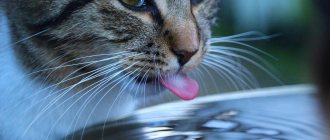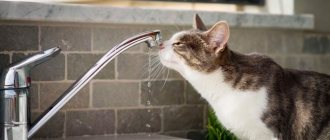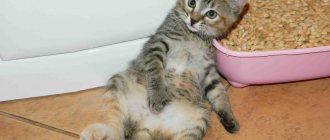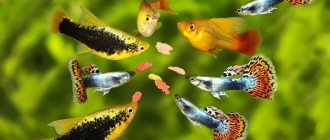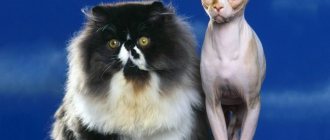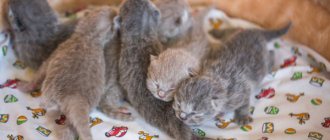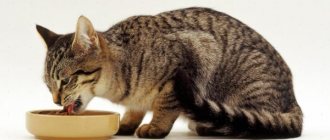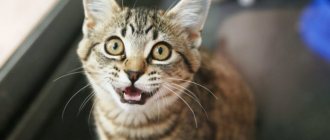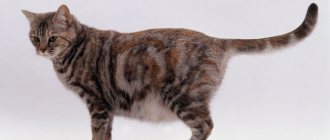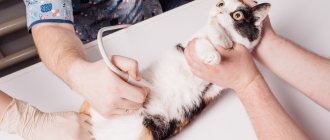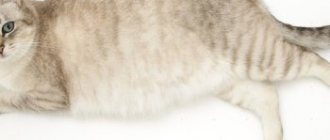- Cats
One of the questions frequently asked to felinologists is: why doesn’t the kitten drink water? Beginning owners worry when it seems to them that the baby is not consuming enough fluids. What if the kitten is sick? Owners experience no less concern if their cat drinks water frequently. How can you tell if your pet is drinking as much as she needs?
The importance of water for a cat's body
The body of any living creature consists of cells. Any cell, in turn, consists of 80% liquid. Each specific cell of the body requires its own set of microelements, which can only enter it when dissolved in water. If a cat does not receive the required amount of water, this can lead to irreversible consequences - drying out, malnutrition, or even cell death. The amount of water your cat drinks is important for blood concentration. The less fluid you consume, the thicker your blood becomes. The heart has difficulty pumping thick blood; oxygen from the blood reaches muscles and tissues more slowly. The heart itself and the entire body as a whole, including the brain, suffer from this due to lack of oxygen. The health of the genitourinary system also depends on fluid intake. A small amount of water leads to a high concentration of salt in the urine, which causes the formation of urinary crystals. Concentrated urine causes urolithiasis in animals, which is very difficult and takes a long time to treat. Neutered cats are especially susceptible to urolithiasis, as they visit the toilet less often and are often less mobile.
Reasons for drinking heavily
High-quality lactation requires more water consumption by animals.
When a kitten or adult cat absorbs a large volume of water, and there is a strong belief that he is healthy, sources of excessive fluid absorption should be sought in external factors. Dry and hot air can provoke thirst: in summer - a sun-heated room where a pet lives, in winter - a heating radiator. The reason for the increased water consumption is the cat’s pregnancy; during lactation, she also drinks a lot, since she gives the liquid with milk to the kitten.
Diet affects thirst. With dry food, you need to drink a lot of water often, since the granule must swell normally in the stomach and be digested. Therefore, in the absence of a mixed diet with the addition of canned food and pates to the diet, the cat should drink at least 400 ml per day. Eating pates and canned food also provides the pet with free access to a drinking bowl, since wet food does not cover the pet’s daily need for liquid.
How much should a cat drink to be healthy?
Very often, cat owners are alarmed when their pets rarely approach the water bowl. Considering that the norm of fluid intake for a cat is from 30 to 40 ml per kg of live body weight, it is enough to weigh the pet to determine the required amount. But you need to take into account that a cat can partially obtain water from food. Especially if she is offered porridge with broth, kefir, milk and other natural products.
In this case, the cat will approach the bowl of water much less often than when feeding dry food. Dry food requires an increase in daily water intake by almost half.
For example, a cat weighing 4 kg should drink from 120 to 160 ml of water per day. But when feeding dry food, he can drink up to 180 or 240 ml. This will be quite normal.
For small kittens who are still close to their mother cat, it is normal to not want to drink water. After all, they can easily get the required amount of liquid per day from their mother’s milk. As the kitten grows, it will have to start drinking water when switching to “adult” food.
If it seems to you that your cat rarely comes to the water bowl and drinks insufficient amounts of water per day, analyze whether the pet can quench its thirst somewhere else. For example, many cats drink tap water with great pleasure. Cats also really like to drink water from large, tall containers. For example, from buckets, filled bowls, even from a filled bathtub. By nature, cats prefer, whenever possible, to choose rather wide and elevated drinking containers.
What determines a cat's need for water?
The constancy of a certain amount of water in a living being is the most important condition for normal life. Every day, a cat loses a certain amount of water through respiration, thermoregulation, and excretion in urine and excrement. That is why the water balance must be restored by consuming liquid from the outside. A cat's need for water depends on:
- Sizes . It has been proven that the smaller the animal’s weight, the higher the need for water per 1 kg of body weight.
- Age . Young growing animals require more fluid compared to adults.
- Level of physical activity . Sedentary apartment animals, spending 18 hours a day in a dormant state, require much less water than their active counterparts who go on adventures on their own.
- Physiological state . Pregnant cats' bodies produce additional fluids, including blood and amniotic fluid, that bathe the kittens in the uterus. A nursing cat also needs to drink more, since the water in her body is transformed into milk, which is given to the babies. Felinologists know that giving milk and sweet tea to a woman in labor stimulates lactation, while females who have undergone a cesarean section may not drink at all, experiencing pain and discomfort after anesthesia.
- Health conditions . Sick cats do not touch water or food, which causes rapid dehydration. If your furry pet has not approached the bowls for 20 hours, this is a serious cause for concern. For small kittens, a critical time period of 12 hours is due to their lower body weight and faster metabolic processes. At the same time, older cats, due to age-related changes and chronic renal failure, may experience severe thirst, but their excretory system is not able to neutralize endotoxins that accumulate in the blood.
- Ambient temperatures . In summer, cats hit more due to the intense work of the thermoregulation system. Due to the lack of sweat glands, baleen-striped animals cannot cool down by sweating, like humans. However, nature has provided compensatory mechanisms for cats: cats suffering from heat begin to lick themselves vigorously, spreading saliva throughout their body and cooling down due to its evaporation. In addition, a small amount of liquid evaporates from the surface of the mucous membranes when a hot cat breathes with its mouth open, and from the paw pads, where the eccrine glands used for marking territory are located.
- Diet. The amount of drinking water consumed also depends on the nature of the diet. Practice shows that an imbalance in water balance can occur when cats are fed exclusively dry food containing a high percentage of protein and minerals with a water deficiency. It is estimated that natural homemade food contains 70-75% water, while in dry food the moisture content does not exceed 10%. To be digestible, the “crackers” must first swell and soak, saturated with water. There is an opinion that for good health, the daily volume of water should be twice the amount of dry food eaten. So, a cat eating 125 g of granules needs to drink 250 ml of water. However, this figure is not canon, since the presence of table salt and flavoring additives in low-quality feed increases thirst.
How to calculate water requirement using formula?
When the question is urgent, and it is fundamentally important for the owner to know the daily rate of water consumption per day by his pet, then there is a simple formula for this: the weight of the cat in grams is multiplied by a coefficient of 0.03 V (ml) = m (g) * 0.03
According to this formula, a 3 kg cat needs approximately 100 ml of water per day. It should be noted that this includes all liquid that enters the body in any form: with milk, canned food, vegetables or other wet food. A kitten needs a little more water per 100 g of weight than an adult pet. On the other hand, a baby who is next to his mother may not drink at all, since his water needs are fully compensated by breast milk, which should also not be forgotten.
How much water a cat should drink depends on the type of food it eats
Cats themselves are low-drinking animals.
They lose moisture from the body more slowly than, for example, people, because they do not sweat, but this does not mean at all that if a cat drinks very little, this is enough for her. Cats prone to urolithiasis (urolithiasis) should generally drink their allot of water per day, since concentrated urine leads to the formation of stones.
This is especially true for castrated cats on dry feeding, since these cats have an increased risk of developing urolithiasis.
According to the general norm, a cat should drink 30 ml of water per 1 kg of weight per day. For example, if a cat weighs 5 kg, his daily dosage of water is 150 ml.
But it all depends on the type of food. If the cat is on dry feeding, then the amount of water drunk should be 2.5-3 times the amount of food eaten. For example, a cat eats 60 g of dry food, which means he should drink 150-180 ml of water. An error of 10 ml in one direction or the other is allowed.
If the cat is on a natural diet or you feed it factory canned food, then the animal’s need for water decreases. Canned food, for example, contains up to 80% moisture. And if we again take a cat weighing 5 kg as an example, then its minimum adequate need for water will be approximately 20 ml per 1 kg of weight or 100 ml. But no less. Even if you are on a liquid diet, your pet still needs clean water. With soup or kefir, the cat will not receive the required amount of minerals.
How to provide a cat with water, which is so vital for it, in the required volume?
Many owners complain that their cat prefers a thin stream flowing from the tap to any source of water. This causes some inconvenience, because keeping the water flowing constantly is impractical, and constantly monitoring the cat and opening the water for it as soon as it shows a desire to do so is impossible. In order to solve the problem, it is necessary to understand the reasons for this behavior of the pet. The truth is that any animal will prefer running water to standing water, because it is the richest in oxygen - this is living water, the one that is needed for the health of the body. Cats instinctively feel this. Some of them like to drink from an aquarium, because the water there is either artificially enriched with oxygen, or oxygen is released by aquatic plants. In addition, the water is purified by filters and has a rich microelement composition resulting from the vital activity of fish and plants.
Thus, in order for the cat to drink enough liquid, it needs to have fresh water at its disposal at all times. How to achieve this? The simplest thing is to put a bowl of the largest, literally “dog” size. The larger the volume of liquid, the longer oxygen remains in it. You can pour water from the tap if you are sure of its quality. If not, filters must be used, but not all animals drink filtered water. Most filters purify water from chlorine and other substances that are used to disinfect it, but while removing harmful things, the filter also removes useful things - salts and microelements. Like boiled water, this water becomes “dead” and therefore unattractive to the cat. The solution may be bottled water, but not just purified water (such as Bon Aqua), but water enriched with microelements (such as Arkhyz, Novoterskaya, etc.) You need to change the water in the bowl as often as possible: several times a day, regardless of whether whether the cat drank or not, because oxygen leaves stagnant water very quickly.
Special devices
To organize a source of “living water” for your cat, you should take advantage of the offers of pet supply manufacturers.
Knowing the problem with drinking in cats, they have long been producing so-called fountain drinkers. All drinking fountains are designed approximately the same, the difference is in shapes, sizes, volumes of liquid, etc. Using an electric pump, water is constantly pumped through a filter that traps wool, dust and other large fractions, and also cleans it of bacteria. Thanks to constant circulation, the liquid is enriched with oxygen, and it needs to be topped up only as natural evaporation occurs - approximately once a week. Depending on the model, a stream of water can simply flow freely from a height, or it can shoot out from the bottom of the drinker, forming an ordinary fountain. In some drinking bowls, this fountain is covered with a dome with a hole at the top, through which water flows freely, constantly forming a thin film on the surface of the dome - cats happily lick it off. This drinking bowl is ideal for long-haired animals, as it does not create splashes at all and allows them to drink without getting their faces wet.
The cost of electric drinkers, of course, is much higher than a regular ceramic bowl - from 2 to 5 thousand rubles. But a device from a good manufacturer will last a long time, and consumes very little electricity - from 2 to 4 W, depending on the size and, accordingly, the volume of the pumped liquid. The only thing you have to regularly spend money on is replacement carbon filters, but in principle you can look at a model without filters at all. In any case, it seems to me that the cat’s health is worth these generally small costs.
Water standards for cats
Physiological studies have established that:
- The fluid requirement of cats is 20-40 ml per 1 kg of body weight per day;
- in small kittens these figures are 2-3 times higher.
That is why it is recommended that babies under 3 months be given exclusively wet food, in particular canned food, meat baby food, cereal or soaked dry food (read the article on how to properly soak dry food for kittens). Lactating kittens up to 3 weeks of age eat exclusively liquid food: mother's milk or formula milk when bottle-fed.
N.G. Grünbaum gives more specific figures and indicates that the average water rate is:
- for adult cats – 31.5 ml per 1 kg of body weight per day;
- for young animals – 77 ml per 1 kg of body weight.
Other liquids. In addition to drinking water, the following are also taken into account:
- milk and lactic acid products (kefir, sour cream, yogurt, fermented baked milk, unsweetened yogurt, cottage cheese);
- broths and gravies of canned wet rations (meat pieces, pates);
- water contained in meat, fish and offal; raw animal products are quite juicy, but when they are boiled, a certain amount of moisture is also retained;
- liquid used to prepare porridge; the carbohydrate part of the cat’s diet consists of oatmeal and other cereals, which need to be well boiled;
- juice of vegetables and fruits, many cats happily eat the “gifts of gardens and vegetable gardens”, giving particular preference to cucumbers;
- water formed in the body itself; It has been established that the oxidation of 1 g of fat supplied with food produces 1.07 ml of water, 1 g of protein - 0.41 ml of water, 1 g of carbohydrates - 0.55 ml of water.
Is all water healthy?
When deciding how much a cat should drink, you should choose water that will benefit your pet.
- Boiled water is dead water, according to scientists. It brings less benefits, and after storage for three hours it even becomes harmful. Many veterinarians believe that drinking boiled water can lead to the development of urolithiasis. Owners with the best intentions quite often try to give their pets this kind of water - sometimes this is the reason why the cat does not drink water. By the way, boiled water changes its properties, turning into a “magnet” for bacteria, viruses and other microorganisms contained in the environment.
- Distilled water is lifeless and useless. It is obtained by boiling - the steam is collected and cooled. All microelements remain “overboard”, and they are vitally necessary for the body. In addition, distilled water almost does not conduct current, and the absence of electromagnetic pulses in moisture leads to a slowdown in the movement of moisture in the body.
- Fresh tap water often contains too many heavy salts, metals, chloride compounds and other “nasties” that are absolutely unnecessary for the cat’s body. Sometimes a cat drinks little because of an unpleasant odor or taste that owners do not notice due to prolonged use of tap water.
- Bottled water is a good option if you can find a quality product. Often, Russian manufacturers (which is officially permitted) sell ordinary tap water, industrially purified and enriched with minerals (an excess of which can lead to the occurrence of ICD), under the guise of “natural” water of the first category.
You should choose water of the highest category, marked “drinking”, obtained from underground sources (the well number, chemical composition and place of production must be indicated on the label). So what kind of water should you give? There are two options: filtered or settled tap water. The water needs to stand in the refrigerator, in a tightly closed glass jug, for six to eight hours.
The influence of ambient temperature on water consumption
Animal water consumption largely depends on the composition of the product and its moisture content. Cats that eat canned food practically do not drink water, since their need for liquid is met through food. The same applies to animals that are fed meat or fish.
Dry food contains only 7-8% moisture, and therefore cats that receive it need more water to meet their physiological needs. In addition, dry food was found to increase fecal water loss but reduce urinary water loss. Although cats' water intake varies greatly, their overall water balance is not affected by the moisture content of their diet.
The drinking behavior of cats, compared to the behavior of dogs, is much less dependent on ambient temperature. This is explained by the fact that in cats, water loss through saliva and exhaled air is not as great as in dogs. For cats to consume more water, it should not be cold.
Cats eat and drink throughout the day, not just during the daytime. They can drink 12-16 times a day, but the volume of water consumed at one time is usually very small: 10-12 ml. However, the drinking behavior of different cats varies significantly depending on the physiological factors discussed above.
To achieve optimal water intake, cats should always have access to it. The water should be fresh, clean and poured into bowls that are convenient for the animals. It is dangerous to leave water in only one room, which may be closed - the animal will be left without water.
Therefore, it is recommended to keep another bowl of water in the house, especially if the cat is left unattended for a long time.
The water given to cats should be free of foreign odors and tastes: these animals are extremely sensitive to odors, although some of them prefer to drink from the toilet, sink, etc. Sometimes cats like to drink from electronic fountains in which the water is constantly aerated. One way to improve the taste of water is to add meat juice, milk and a small amount of salt to it.
Switching to feeding cats canned or liquid food are alternative ways to increase their water intake.
Why does a cat refuse water?
As mentioned above, cats are light-drinking animals. However, sometimes it happens that a pet completely refuses to drink. There may be several reasons.
- Disease. The cat approaches the bowl of water, but does not drink at all or very little. At the same time, he often licks his lips. Perhaps his teeth or gums hurt, problems with the mucous membranes. If a cat frequently uses the litter box, but urinates a little each time, and the urine itself has an unpleasant odor and is mixed with blood, it is possible that the animal suffers from urolithiasis. Lethargy, fever, discharge from the eyes, nose, vomiting are already signs of an infectious disease.
- Stress. Emotional discomfort in a cat can be caused by anything. For example, the noise of renovations from neighbors or the arrival of a large number of guests in your home. A frightened pet can sit in a shelter all day, no thirst will force him to leave the shelter;
- Hormonal surge. During the period of the so-called sexual heat, animals can forget about everything in the world.
- Dissatisfaction with the drinking bowl and water quality.
General rules
So, it is absolutely normal for cats to drink little but often. If you are thinking about how to get your cat to drink more water, start by calculating its daily fluid intake and compare this figure with the amount that disappears from the bowl. In hot weather, this observation is more difficult to make because the water evaporates quickly. There is no need to be alarmed if your cat drinks water with its paw, but make sure that:
- The bowl is not too narrow - the whiskers should not curl when the cat drinks.
- The bowl is too deep - it is better to use wide and shallow bowls.
- The cat does not experience pain when bending its neck.
- The cat's teeth are healthy.
- The water is not too cold.
- The water is clean.
At any time of the year, especially in winter and summer, the cat should have unhindered access to water. The volume of the drinking bowl should exceed the animal's daily fluid intake by at least 50%. The bowl should be washed every day, 2-3 times a day in summer. These conditions are especially relevant for animals kept on dry food , since the granules swell after ingestion, and provoke extreme thirst.
If you are going on a trip, stock up on clean water to give your cat water on the road. If this moment is missed, do not even think about giving your cat water collected from a puddle or pond. Most likely, such a decision will lead to dysbiosis and infection with worms. It is worth understanding that water from puddles and standing reservoirs may contain eggs of very dangerous helminths.
Important! Do not allow your cat to drink water from the aquarium or toilet. In the first case, there is a high chance of a bacterial outbreak (the microflora of the aquarium is very specific), in the second, comments are unnecessary.
Water consumption rate
Let's figure out how to calculate the amount of water a cat should drink per day? The daily norm is calculated in several ways, and its fluctuations depend on the weight of the animal and the type of food it eats. You need to understand that the indicator obtained during the calculation process is not the absolute truth for each individual animal. The resulting volume of liquid is a guideline, that is, if the cat begins to drink more or less, it needs to be shown to a doctor or at least carefully monitored.
According to generally accepted rules, the daily water intake is calculated based on weight, namely: 20–40 ml per 1 kg of weight . Some veterinary reference books indicate slightly different information: the rate of water consumption is 50 ml per 1 kg of weight per day. Kittens drink a little less, adult cats drink more.
Some recommendations apply to animals that eat only dry food. The daily water intake should be twice the weight of the food eaten. That is, if a cat eats 150 grams. granules, she should drink at least 300 ml of water. This indicator is not justified from a practical point of view if the cat is kept on high-quality food that does not contain salt.
When calculating your daily water consumption, you need to take into account one more nuance, namely the type of food. We talked about dry food above, but if a cat eats natural food, the amount of water it drinks may decrease if the cat receives milk, broths, canned food with gravy and other wet food.
Factors influencing water consumption
Having calculated the daily water intake for a cat and discovered that the pet does not drink it (or drinks more), you need to take into account several more factors. The fact is that a cat drinks according to its needs, no more and no less. At the same time, there are a number of ailments that increase thirst or cause the cat to refuse to drink .
Unless sick, your cat may consume more water for the following reasons:
- Hot weather - the cat becomes thirsty as natural fluid loss increases.
- Dry air - thirst increases as the mucous membranes quickly dry out.
- Pregnancy - the mother's body constantly produces additional blood and amniotic fluid.
- Rehabilitation after childbirth and lactation - the cat should drink a lot more water, since excessive fluid consumption leads to dehydration.
A sharp decrease in water consumption or temporary refusal of it may be associated with:
- Rehabilitation after surgery - after recovering from anesthesia, the cat may refuse water. In this case, the mouth must be forcibly wetted, but there is no need to fill it with water. After long operations, it is sometimes necessary to put drops in the eyes and nose (to moisturize).
- Dampness – the cat loses less moisture.
Important! Refusal of water for 20 hours in an adult cat and 12 hours in kittens is not normal; the cat needs help and it is better to contact a veterinarian immediately!
How to Increase Water Levels in Your Cat's Diet
Urinary tract problems occur due to lack of water. Owners must do everything possible to ensure that their cats' diet ensures normal body function. Unfortunately, many veterinarians still recommend dry food to their patients. But raw meat is a common food for cats. It is more filling and better absorbed by the body.
To provide your cats with a natural diet, you don't have to learn recipes or cook your own food. You can buy ready-made food from manufacturers such as SUPERPET. Then the amount of fluid that cats receive will be sufficient, dissolved substances and minerals will be regularly excreted in the urine, the urine pH will be acidic, and the bladder will be healthy.
IMPORTANT: animals with urinary tract obstruction need urgent veterinary help! Without the help of a specialist, we are talking about a threat to the life of your pet.
